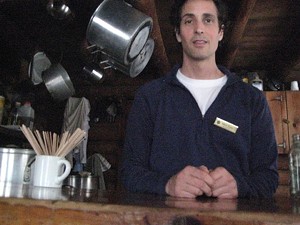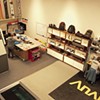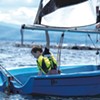Published January 20, 2010 at 6:06 a.m.
Many are the reasons we ski, snowshoe, hike and bike: fun, fitness, fellowship and the gratification that comes from getting somewhere under our own steam. Whether the goal is a hut, a pinnacle or a creemee stand — the end of Lone Rock Point or the summit of Denali — you’re generally loath to stop and turn around before you reach it.
That reasoning is how I ended up legs akimbo, splayed in the middle of an aggressively precipitous trail on my way to the Slayton Pasture Cabin at the Trapp Family Lodge. I’d made it my goal to ski to the cabin, and ski to the cabin I would, no matter how many times I fell over in the process.
The von Trapp family of The Sound of Music fame built Slayton Pasture Cabin in 1971 as a way station of sorts for skiers visiting the Stowe resort’s 100 kilometers of cross-country ski trails. It provided, and still provides, a rest stop where weary ski travelers could refuel by a toasty fire with soups, sandwiches, hot drinks and sundry snacks. Over the years, the cabin has become the destination for tourists visiting “Trapps.”
Generally on a winter weekend, the cabin is packed with skiers looking to warm up and eat before heading back out to the trails. Mike Gora, who has served as the cabinkeeper since 2000, said the crowds are so dense on Saturdays and Sundays that often people can’t find a place to stand inside. On the weekday when I ventured to the cabin, I had the whole place to myself save for a mother-daughter pair on Nordic skis as old as Johannes von Trapp.
Like many of the tourists who trek the 5 kilometers to the cabin, I was enticed by the idea of skiing to a destination, of being able to say, “I made it.” In actuality, skiing to the cabin is not exactly a feat on the order of skiing all 300 miles of the Catamount Trail. But it is one of the most popular skis in the region, and something you can tick off your list of things to do before you die.
I learned to cross-country ski a week before my trip to the vaunted cabin. This is not something I would recommend. The most direct route is a black trail, meaning it should be attempted by someone with more than four hours on skis the width of golf clubs. But I had gotten the hang of the basics quickly, so I figured I’d be OK.
I brought along my friend Alison for moral support. Alison has skied for 20 years and knows the Trapp trails well. Plus, she is resourceful and could be called on for assistance in the event that I face-planted in the snow and couldn’t figure out how to get back up.
The weather was not ideal for Nordic skiing. The thermometer in my car read 33 degrees, and the sky was schvitzing. Had I known anything about the complicated calculus that is ski waxing, I probably would have been concerned. My partner in crime slopped goopy red wax on her skis so she wouldn’t slide down the hills. I just wiped some all-purpose paste wax on mine and hoped for the best.
The wind whistled across the parking lot, and I questioned whether my hour’s worth of ski tuition would see me safely to the cabin. But I didn’t have time to fret; it was 2 p.m. and we had a deadline. The cabin is open from 10 a.m. to 3 p.m., mid-December through mid-April, though people continue to drop in after it is technically closed, Gora said.
Our trip began on Sugar Road, a broad, mostly flat track that heads north away from the ski center. The tracks set on either side of the trail were inviting, but the balmy weather made them slick, so we were better off sticking to the middle.
As we skied toward the picnic knoll 2 kilometers away, we were passed by a handful of first-time skiers getting lessons. I commiserated with them — just a week before I had been practicing squeezing an orange between my knees, a technique the instructor encouraged me to use when stopping.
In good time we reached the picnic knoll, an open, rolling hill about halfway between the ski center and the cabin, and I felt confident we’d reach our destination before closing. Alison laughed. “That was mostly downhill,” she said, psyching me out.
Ahead of us was the start of the Cabin Trail. After a drink of water and a few pointers on how to navigate the steep uphill climbs, we were off. Immediately, I needed to shed layers. Since I am new to this sport, I did not yet have my clothing combination dialed. I was either roasting or freezing.
Because the Cabin Trail is practically vertical, there’s not much skiing to be done there. It requires either sidestepping, which is slow and cumbersome, or the herringbone method. I chose the latter.
With my feet turned out and my skis in a V-shape, I picked my way up the trail. Alison, who seemed to float up it, turned around every so often to make sure I wasn’t lying facedown in the snow. Sometimes she would ski down to me and then magically zip back up the hill.
I fell twice trying to herringbone. On one fall, I lost my ski and watched helplessly as it skittered down the hill. Alison retrieved the runaway as I sat there wondering why I didn’t just walk up. At this rate, a small child could have toddled to the top faster than I was skiing.
About halfway up the Cabin Trail, which wends its way into pristine conifer stands, I had a dropout moment. This is the point in any physical exertion when you are about to quit. Every muscle in your body is yelling at you to stop, sit down, pout a little and go home. And yet somehow you keep going.
Once we made it through the brutal uphill section, the trail flattened a bit for the last 1 and a half kilometers. As we skied, I kept having visions of the cabin. I fantasized about seeing its snow-covered roof through the trees. Finally, I did. About 55 minutes after we left the ski center, Alison and I reached our goal.
We popped off our skis and ventured inside. There Gora, a laconic, curly-haired 46-year-old who looks not a day over 30, greeted us. He offered us hot cider, which I enthusiastically accepted, and showed us to the stone fireplace where a few logs crackled in the flames.
Gora lives at the cabin five days a week. He is responsible for cooking the soups, fixing the sandwiches and making sure the pipes running to the water pump don’t freeze. He also has to feed the birds — a “full-time job,” Gora said. The chickadees, nuthatches, blue jays and hairy woodpeckers that frequent the cabin are very demanding and tap on the window when their feeders are empty.
Gora began working at the resort a decade ago. Back then, the work was just seasonal, tending the Trapp gardens. When the cabinkeeper job became available, he jumped on it, mostly because of the skiing opportunities it provided. Gora lives for skiing.
About once a week, the groomers tote groceries up to the cabin, with which Gora cooks vats of soup. On this day, he had made something called Cabin Vegetable, as well as a carrot-ginger-zucchini soup, which was hearty and chunky — just what you’d want after slogging up the Cabin Trail. And at $3.50 a bowl, the price was right. Gora isn’t a cook by trade; he’s had to learn by doing. “I’ve definitely gotten better over the years,” he claimed.
As I ate my soup, Gora explained the draw of the cabin. It’s the fact that it’s a destination, he reasoned, and unique to Trapps. Plus, it’s laid back, it’s friendly, and “nothing ever has to happen right away up here.” Gora guessed that far fewer people would ski at Trapps without the cabin. With single-day passes priced at $22, one of the priciest Nordic tickets in the state, he might be right.
We packed up to leave as Gora washed the day’s dishes with hot water from the propane stove, another of his duties. He paused for a second to push two lapel pins into my hand. They read, I skied to Trapps Slayton Pasture Cabin and featured a coppery rendering of the structure — a small badge of honor after an exhausting ski. “These sell like hotcakes,” Gora said. “They don’t sell these back down at the ski center. You have to make it up here to get one.”
More By This Author
Speaking of...
-

Last Quarter: Spring 2024 Vermont Housing News
Apr 16, 2024 -

New Owners of Robert Paul Galleries Look to the Future
Mar 6, 2024 -

Michael Krasnow Has Spent Decades Giving Kids Skis, Snowboards and a Taste of Independence
Jan 31, 2024 -

Stowe’s Cork Restaurant Pleases With Wine and Italian-Inspired Comfort Food
Jan 9, 2024 -

Q&A: Howard Fisher Delivers Meals on Wheels With a Side of Good Cheer
Dec 20, 2023 - More »
Comments
Comments are closed.
From 2014-2020, Seven Days allowed readers to comment on all stories posted on our website. While we've appreciated the suggestions and insights, right now Seven Days is prioritizing our core mission — producing high-quality, responsible local journalism — over moderating online debates between readers.
To criticize, correct or praise our reporting, please send us a letter to the editor or send us a tip. We’ll check it out and report the results.
Online comments may return when we have better tech tools for managing them. Thanks for reading.













































